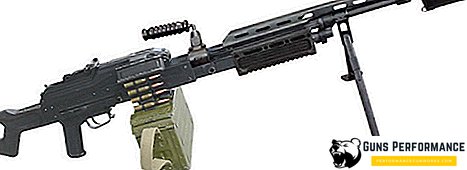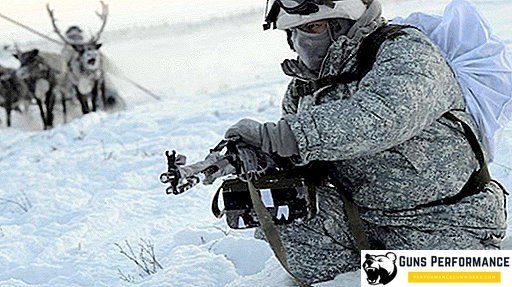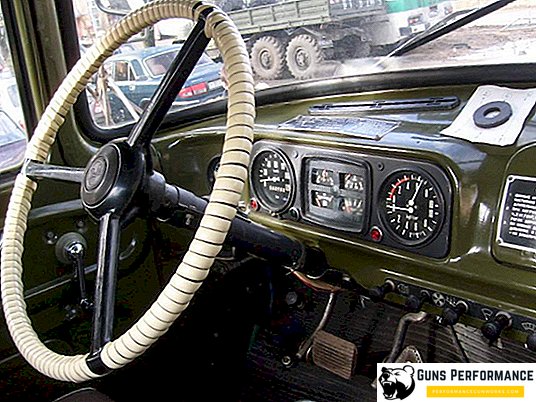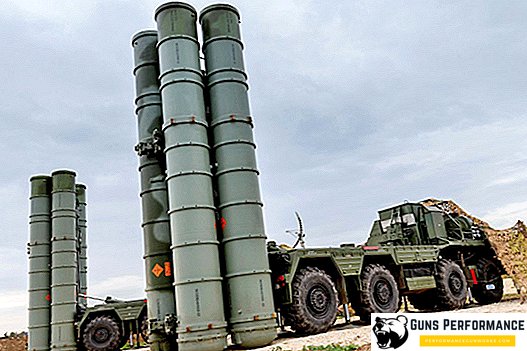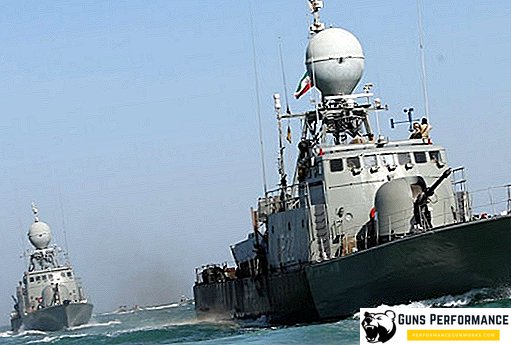GAZ-67 - Soviet-made all-wheel drive SUV. The main features were a simplified body structure with missing doors (cutouts instead) and a unique bridge design. The development of transport involved V.A. Grachev The basis of the car, he put his own development of the GAZ-64, used the technical components of the GAZ-M1. The Soviet army used a jeep during the Great Patriotic War and the Korean War.
General information about GAZ-67

The military among themselves called transport "goat" or "goat." Over 10 years of production (1943-1953), the plant collected about 93 thousand copies. Low output was observed until the end of the war. During this time, 6 thousand cars left the assembly line. This is a tenth of the volume of vehicles supplied from other countries as part of military support.
The most popular was the modification with the index "B". After the end of the Second World War it was used in the army, the Ministry of Internal Affairs, the Ministry of State Security and the economic sectors (in agriculture, forestry and geological exploration). Engineers of the Gorky Automobile Plant produced several varieties of narrow specialization based on equipment.
The history of the creation and development of GAZ-67
The appearance of the classic version
At the end of September 1942, the management of the Gorky enterprise approved a plan, according to which Grachev was required to conduct a global refinement of the 64th model. The team under his leadership began work in February next year. The best GAZ specialists for several months worked on the development of the first prototype.
The first three copies had a lot of defects, the main one of which was a narrow gauge. This affected the patency. In May 1943, engineers conducted a global revision, bringing the gauge to the desired value. For this, we had to modify the frame of the GAZ-67, amend the case and change the mount of the muffler.
At the end of July 1943, the GAZ-67B was first mentioned at the plant, having assembled the chassis of a new generation. Soon, an additional letter in the name was abolished. She returned an upgraded version of the SUV a year later. The final model was collected in August. Factory tests were held in the fall. During them, the jeep passed all instances with satisfactory results.
In total, the transport equipped with the ZIS-3 cannon covered 2,200 kilometers. Testing took place on asphalt and priming roads, as well as off-road. According to the test results, the designers realized that using a car with a gun on board was a bad idea. Serious defects in the device did not reveal, but some modifications were required.
The first car on the conveyor collected September 23, 1943. For a couple of weeks, the experts completed the production process, collecting 10 machines. In the following months, the pace increased. By the end of the 43rd year, 718 cars had left the workshop walls. At the end of 1945, the total number of collected copies was at around 6,000.
The appearance of the modernized GAZ-67B

At the beginning of the 44th year, the engineers demonstrated to the management of the company an improved version, which received an index "B". Within five months, the equipment passed field tests, on which it traveled about 20 thousand kilometers in various conditions. The test results were so much liked by the military commanders that they ordered the immediate deployment of mass production of the new model.
The first year "B" did not appear in the official documentation, so the name was only internal in nature. Until the end of the 40s, many soldiers confused the 67 and 64 models of the military SUV. For a long time, they believed that the standard version of the GAZ-67 is a modernized version of the GAZ-64 with improved bridges and increased gauge. Widespread popularity due to modification "B" transport received by the end of the 40s.
Design and characteristics of GAZ-67

GAZ-67 specifications:
- Length - 3.4 m;
- Width - 1.7 m;
- Height - 1.7 m;
- Ground clearance - 23 cm;
- Weight - 1.3 tons;
- The volume of the power unit - 3.28 l;
- The power plant capacity - 54 horsepower at 2.8 thousand revolutions;
- The maximum speed is 90 km / h.
Hodovka

Engine compartment aerodynamics improved due to the introduction of exhaust slots. They were placed on the back of the hood. The base was shortened by 755 millimeters (when compared with the GAZ-61). Due to this, the intermediate cardan shaft was excluded from the device. The open driveshaft, located in front, supplemented with hinges on needle bearings.
Patency increased by using four-quarter-elliptical springs in the front axle. Because of this, there were drawbacks: frequent breakage of sheets (due to uneven distribution of the load) and a low level of lateral stiffness. Springs GAZ-67 received new threaded fingers and bushings. This improved the stability of the car on the straight road.
The short base and special design of the bridges on the first prototypes led to heavy galloping. Having equipped the suspension with powerful hydraulic shock absorbers, the deficiency was eliminated. Until 1951, single-sided shock absorbers were used, which had low strength and low efficiency. From 1951 to 1953, SUVs were equipped with double-acting shock absorbers.
Rear springs placed over the casing of the bridge. Console brackets acted as a support on the frame. Thanks to this solution, it was possible to increase the ground clearance and allowed us to abandon the anti-roll bar. All major components of the front suspension strengthened.
Tie Rod and Brakes

The steering rod was straight, it was placed in front of the front axle. Due to the lack of bends, it turned out to be tough, but more vulnerable to frontal impacts. The inclination of the GAZ-67 steering wheel was 10.27 degrees, which was a lot at that time (this did not affect the handling quality).
Rope-type brakes on all wheels were driven by a mechanical drive. To improve the efficiency of the brake system added a hard camshaft. To activate the brakes, the driver used a pedal or hand lever. Equalizers in the device are not added to increase the working resource stock.
Tires GAZ-67

Tires with a grouser of the "dissected Christmas tree" type were taken from the previous generation. With the help of them, the technician felt confident on the roads and the ground. The Yaroslavl enterprise was engaged in the production of tires specifically for Gorky developments. The crisis in the war years affected the release of tires, so some GAZ-67s were equipped with wheels from M1. Their main disadvantage was the highway tread pattern (this worsened off-road permeability).
Body

The body was open. Transportation accommodated up to four people. The front seat was divided, the back was made combined. The rear wings are designed to accommodate two more soldiers. If the crew did not need additional assistance, boxes for the transportation of weapons and ammunition were attached to the wings. The doors were missing. In bad weather, the body and doorways were covered with a special awning.
The windshield was attached to the frame, which was folded forward or fixed in a horizontal position. On the driver's side there was a wiper. When assembling the body used flat or bent in the same plane shape of the box construction. The design of the front is taken from Gorky-GAZ-AA.
The track width was 1,445 millimeters. Sometimes in production there were failures, because of which it could increase up to 1 460 mm. The strength of the frame was increased by installing spars with a closed profile. The front bumper protruded beyond the body by 40 mm. This made it possible to eliminate the appearance of cracks in the most heavily loaded areas of the frame.
Power unit

The GAZ-67 engine developed 54 horsepower at 2.8 thousand revolutions. At 1.4 thousand revolutions, the greatest torque was reached - 18 kgf / m. The engine worked along with the K-23 carburetor, which was innovative in those years. Its design was deprived of a pneumatic economizer. The accuracy of the adjustment has become higher. To the left of the power plant was an air filter. With the help of a long pipe he connected to the carburetor.
The main tank of 43 liters was located in front of the windshield. Under the driver's seat was an additional fuel tank that could hold 33 liters of gasoline.
In the 67th model there was a minimum amount of electrical equipment and appliances. The basis was taken dashboards from M1 and MM with the removal of indicators of oil and coolant temperature.
GAZ-67B
The main task of engineers in creating a new modification was an increase in the shelf life of the main technical units:
- Installed new bearings "White". They were distinguished by high strength, increased stock of working resource, exposure to shock loads;
- Front wheel hubs are reinforced bearing mount;
- The driveshaft was equipped with new spitz seals;
- On all fastenings of the front springs, the ladders were replaced with reinforced through-bolts.
Until the end of the 1950s, many technical units were used on other Gorky light SUVs. The GAZ-67B engine received an improved distributor, which was connected to the candles by means of high-voltage cables covered with insulating material.
In the following years, the device was supplemented with improved elements unified with new developments of GAS. In 1948, the usual grille replaced stamped with seven vertical slots.
What can be concluded?

GAZ-67 - the legendary Soviet SUV, which in its time had an innovative design. High quality is confirmed by a long production (10 years) and a large number of collected copies (about 93 thousand). Some drawings of technology today can be found in the archives of the Gorky Automobile Plant.
During the Second World War, a jeep was often used in reconnaissance operations. After the end of the war, it was used in many areas, including the national economy. Until 2018, there are few cars. Rare models can be found at military exhibitions or in private collections. After the war, on the basis of the GAZ-67, NAMI specialists developed amphibians.


